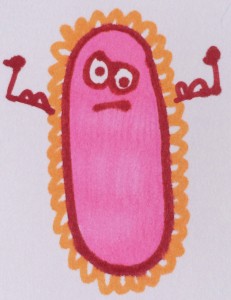 Haemophilus influenza type b is a bacterium that can cause severe invasive diseases in infants, such as meningitis, epiglottitis, with neurologic sequelae and death.
Haemophilus influenza type b is a bacterium that can cause severe invasive diseases in infants, such as meningitis, epiglottitis, with neurologic sequelae and death.
Haemophilus influenza (H. influenza) may be living in your nose and throat at all times and you do not even know it. In fact, you may not have ever come down with the illness and still have it in your body. And unfortunately, should someone who has it cough or sneeze and your child inhales the particles, it has the potential to make your child life-threateningly ill.
Hib, not to be confused with the influenza virus that causes the “flu”, is responsible for serious childhood illness. There are several types, or strains of H. influenza, however H. influenza type b (Hib) tends to be the culprit that can land your child in the hospital.
Once Hib enters your child’s body, it takes on a life of its own. Commonly, it will cause ear and throat infections, which your child has the chance to overcome with antibiotics, however many Hib infections in children under the age of five become severe.
Severe infections occur when the Hib bacteria invade parts of the body that are normally free from germs; when this happens, the disease is called “invasive”. Unfortunately, many invasive infections caused by Hib can result in death.
These are common invasive illnesses caused by Hib:
1. Meningitis: An infection of the covering of the brain and spinal cord.
- The symptoms of meningitis include:
- Fever
- Headache
- Stiff neck
- Nausea
- Vomiting
- Sensitivity to light
- Confusion
- Very serious and causes death in 1 out of 20 children.1
- 10-30% of children that survive meningitis have permanent brain damage.1
- Infants that get meningitis appear to be limp and lose their sense of alertness. They usually will eat less, may be vomiting, and have poor reflexes.
2. Epiglottitis: A life-threatening infection of the throat.
3. Pneumonia: Occurs when the lungs become infected and swell. Symptoms of pneumonia usually include:
- Fever
- Cough
- Shortness of breath
- Chills
- Sweating
- Chest pain that comes and goes with breathing
- Headache
- Muscle pain
- Excessive tiredness
4. Bacteremia: An infection of the blood. It can cause symptoms such as:
- Fever
- Chills
- Excessive tiredness
- Pain in the belly
- Nausea
- Vomiting
- Diarrhea
- Anxiety
- Shortness of breath
- Confusion
5. Cellulitis: An infection of the skin.
6. Arthritis: An infection of the joints.
7. Osteomyelitis: An infection of the bone.
If your child should come down with a mild case of Hib, your doctor will treat him with antibiotics that last for ten days. However, even when given proper antibiotics somewhere between 3% and 6% of children with Hib still die from it. And in the case of an invasive disease, your child will need to be hospitalized.
Along with children under five, your child may have an even higher risk of contracting Hib if he is American Indian or an Alaska Native. Also, if your child has a medical condition such as sickle cell anemia, if he has had his spleen removed or damaged, has HIV/AIDS or another immune system disease, is being treated with drugs such as steroids, has an antibody or complement deficiency syndrome, has had a bone marrow or organ transplant, or is getting cancer treatment with x-rays or drugs, he has an even higher chance of contracting Hib.
The Hib vaccine is highly recommended for the special risk groups above, as well as for all young children because it will protect them from getting invasive infection should they happen to pick up the Hib bacteria.
Resources
- Centers for Disease Control and Prevention (CDC). www.cdc.org
- Vaccines.gov. www.vaccines.gov
- Picture courtesy of the Centers for Disease Control and Prevention (CDC). www.cdc.org
